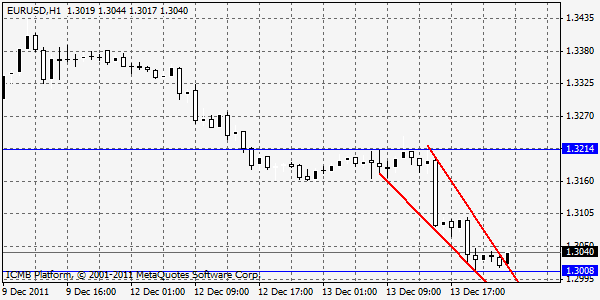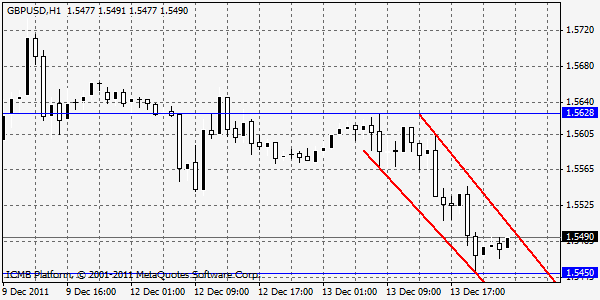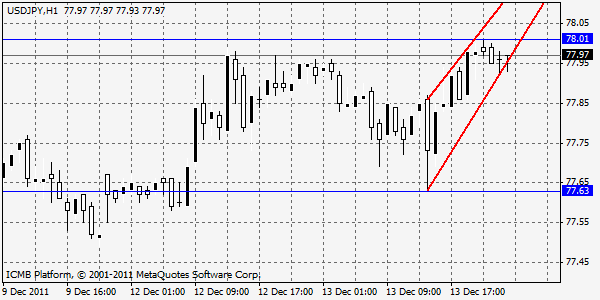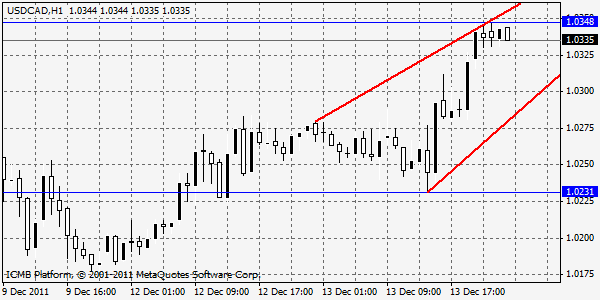EUR/USD
The euro fell to an 11-month low against the dollar on concern European leaders won’t agree on ways to expand the region’s rescue capacities as debt-strapped nations struggle to fund their deficits and when Fed retained the interest rate at 0.25% until mid of 2013 as no signs for QE3. Merkel, during a meeting of her Christian Democratic caucus in Berlin, confirmed the limit on the European Stability Mechanism as agreed by European Union leaders at a summit last week. For the time being, Germany deflected a move to grant the ESM a banking license, which would enable it to multiply its firepower by borrowing from the ECB. The euro’s tumble below its weakest levels against the dollar reached during October and November suggests the 17-nation currency may weaken to its lowest level this year. European banks may be selling assets in Asia as prices on sovereign-debt holdings fall, driving down stocks in emerging-market countries and supporting the euro. Europe owns about 10 trillion euros ($13 trillion) of foreign assets such as factories, stocks and bonds that it might sell to help ease its debt crisis. European leaders unveiled a blueprint last week for a closer fiscal accord to save the currency, adding 200 billion euros to their current bailout fund and tightening rules to curb future debts. They also agreed to move up the creation of the ESM and said that by March the EU will reassess plans to cap the overall lending of the ESM and the temporary fund at 500 billion euros.

GBP/USD
Driven by a slower increase in food prices, U.K. inflation eased further in November amid weak economic activity. Annual inflation came in at 4.8 percent as expected, the lowest since August. Although the rate slowed from 5 percent in October, it continues to hover above the 2 percent central bank target. Bank of England policymakers have argued for a long time that inflation at elevated level will prove to be temporary. Elsewhere, Bank of England Chief Economist Spencer Dale said inflation may come down to around 3 percent by March next year but the price developments beyond that is crucial for the future stance of monetary policy. Month-on-month, consumer prices climbed 0.2 percent as expected, after rising 0.1 percent in October. The increase was within the normal range for an October to November movement. The largest downward pressures to the change in annual inflation came from declines in the cost of food, petrol, clothing and furniture, household equipment and maintenance. Prices of food and non-alcoholic beverages were higher by 4 percent in November, but the pace of increase was slower than the 5 percent growth logged in October. Clothing and footwear costs moved up 2.8 percent, while costs of furniture and household goods were higher by 5 percent. Stripping out volatile energy, food, alcohol and tobacco, core inflation eased more than expected to 3.2 percent from 3.4 percent. The expected rate for November was 3.3 percent. Retail price annual inflation also slowed in November to 5.2 percent from 5.4 percent a month ago. The figure was the weakest since July 2011, when the rate was 5 percent. Economists had expected the annual rate to fall to 5.1 percent.

USD/JPY
Japan is on today scheduled to release final October numbers for industrial production, highlighting a modest day for Asia-Pacific economic activity. Little change is expected from last month's preliminary reading that showed a monthly increase of 2.4 percent and an annual increase of 0.4 percent, while capacity utilization was down 3.6 percent on month. An index measuring tertiary industry activity in Japan was up a seasonally adjusted 0.6 percent on month in October, the Ministry of Economy, Trade and Industry said, standing at 98.7. That beat forecasts for an increase of 0.4 percent on month following the 0.7 percent contraction in September. Industries that contributed to the increase included computer software, communications, retail trade, personal services, accommodations, health care, electricity and real estate Industries that moved lower included scientific research, automobile maintenance, technical services, finance and insurance and compound services.

USD/CAD
Canada’s dollar dropped to its weakest level this month after the Federal Reserve supported the U.S. currency by refraining from taking new action to lower borrowing costs. The loonie fell earlier after German Chancellor Angela Merkel said a cap on the European Stability Mechanism will stay in place. Canadian government 10-year bonds rose after the Fed’s statement. The loonie depreciated 0.7 percent to C$1.0343 per U.S. dollar at 5 p.m. Toronto time after reaching C$1.0349, its weakest since Nov. 30. One Canadian dollar buys 96.68 U.S. cents. The absence of the hint that they might loosen further in the future creates a very small, knee-jerk U.S. dollar-positive reaction. Given the markets lack of focus on fundamentals lately, the loonie by all accounts, for a growth sensitive currency is holding its own outright. Both the crosses and oil patch names to date have been able to slow the dollar’s rise somewhat. Until this morning, the currency outright had been trading tight against its upper band for most of the week. Nevertheless, these levels are beginning to run short of dollar CAD buyers who are been beaten back by Euro toxic rhetoric. Without dollar resistance, at the weekly highs, the loonie has the ability to fall to its next target of 1.0350. Depending on how CAD performs on the crosses, investors can expect a slow grind to lower CAD levels that will give them a better entry average to wanting to own the currency. Do not be surprised to see 1.0500 within the next two-week, mostly due to the lack of liquidity this time of year. EUR/CAD certainly found strong resistance just under 1.40, and with an unconvincing Euro-summit market outcome last week, continues to give the second tier safer havens a boost.

The euro fell to an 11-month low against the dollar on concern European leaders won’t agree on ways to expand the region’s rescue capacities as debt-strapped nations struggle to fund their deficits and when Fed retained the interest rate at 0.25% until mid of 2013 as no signs for QE3. Merkel, during a meeting of her Christian Democratic caucus in Berlin, confirmed the limit on the European Stability Mechanism as agreed by European Union leaders at a summit last week. For the time being, Germany deflected a move to grant the ESM a banking license, which would enable it to multiply its firepower by borrowing from the ECB. The euro’s tumble below its weakest levels against the dollar reached during October and November suggests the 17-nation currency may weaken to its lowest level this year. European banks may be selling assets in Asia as prices on sovereign-debt holdings fall, driving down stocks in emerging-market countries and supporting the euro. Europe owns about 10 trillion euros ($13 trillion) of foreign assets such as factories, stocks and bonds that it might sell to help ease its debt crisis. European leaders unveiled a blueprint last week for a closer fiscal accord to save the currency, adding 200 billion euros to their current bailout fund and tightening rules to curb future debts. They also agreed to move up the creation of the ESM and said that by March the EU will reassess plans to cap the overall lending of the ESM and the temporary fund at 500 billion euros.

GBP/USD
Driven by a slower increase in food prices, U.K. inflation eased further in November amid weak economic activity. Annual inflation came in at 4.8 percent as expected, the lowest since August. Although the rate slowed from 5 percent in October, it continues to hover above the 2 percent central bank target. Bank of England policymakers have argued for a long time that inflation at elevated level will prove to be temporary. Elsewhere, Bank of England Chief Economist Spencer Dale said inflation may come down to around 3 percent by March next year but the price developments beyond that is crucial for the future stance of monetary policy. Month-on-month, consumer prices climbed 0.2 percent as expected, after rising 0.1 percent in October. The increase was within the normal range for an October to November movement. The largest downward pressures to the change in annual inflation came from declines in the cost of food, petrol, clothing and furniture, household equipment and maintenance. Prices of food and non-alcoholic beverages were higher by 4 percent in November, but the pace of increase was slower than the 5 percent growth logged in October. Clothing and footwear costs moved up 2.8 percent, while costs of furniture and household goods were higher by 5 percent. Stripping out volatile energy, food, alcohol and tobacco, core inflation eased more than expected to 3.2 percent from 3.4 percent. The expected rate for November was 3.3 percent. Retail price annual inflation also slowed in November to 5.2 percent from 5.4 percent a month ago. The figure was the weakest since July 2011, when the rate was 5 percent. Economists had expected the annual rate to fall to 5.1 percent.

USD/JPY
Japan is on today scheduled to release final October numbers for industrial production, highlighting a modest day for Asia-Pacific economic activity. Little change is expected from last month's preliminary reading that showed a monthly increase of 2.4 percent and an annual increase of 0.4 percent, while capacity utilization was down 3.6 percent on month. An index measuring tertiary industry activity in Japan was up a seasonally adjusted 0.6 percent on month in October, the Ministry of Economy, Trade and Industry said, standing at 98.7. That beat forecasts for an increase of 0.4 percent on month following the 0.7 percent contraction in September. Industries that contributed to the increase included computer software, communications, retail trade, personal services, accommodations, health care, electricity and real estate Industries that moved lower included scientific research, automobile maintenance, technical services, finance and insurance and compound services.

USD/CAD
Canada’s dollar dropped to its weakest level this month after the Federal Reserve supported the U.S. currency by refraining from taking new action to lower borrowing costs. The loonie fell earlier after German Chancellor Angela Merkel said a cap on the European Stability Mechanism will stay in place. Canadian government 10-year bonds rose after the Fed’s statement. The loonie depreciated 0.7 percent to C$1.0343 per U.S. dollar at 5 p.m. Toronto time after reaching C$1.0349, its weakest since Nov. 30. One Canadian dollar buys 96.68 U.S. cents. The absence of the hint that they might loosen further in the future creates a very small, knee-jerk U.S. dollar-positive reaction. Given the markets lack of focus on fundamentals lately, the loonie by all accounts, for a growth sensitive currency is holding its own outright. Both the crosses and oil patch names to date have been able to slow the dollar’s rise somewhat. Until this morning, the currency outright had been trading tight against its upper band for most of the week. Nevertheless, these levels are beginning to run short of dollar CAD buyers who are been beaten back by Euro toxic rhetoric. Without dollar resistance, at the weekly highs, the loonie has the ability to fall to its next target of 1.0350. Depending on how CAD performs on the crosses, investors can expect a slow grind to lower CAD levels that will give them a better entry average to wanting to own the currency. Do not be surprised to see 1.0500 within the next two-week, mostly due to the lack of liquidity this time of year. EUR/CAD certainly found strong resistance just under 1.40, and with an unconvincing Euro-summit market outcome last week, continues to give the second tier safer havens a boost.

